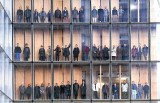This research paper treats a series of questions concerning the ways human encounter is expressed within the public building. In particular, this research paper puts the question of how human presence is inserted into the spatiality of public building, in relation to the particular architectural and structural features that enhance human encounter.
The very idea of human encounter in its “rituality” is studied through the various kinds of this encounter, focusing on the human spatial movements as they are substantiated in the public building.
Human encounter as intercourse is thematized:
Firstly, in relation to the spatial organization as gradual procedure in its given rituality. Herein, the questions of how the architectural organization of the gradual encounter is manifested in the public building are analyzed. This analysis is supported by spatial paradigms such as the square, the internal courtyards, the atrium, the bridges and the ramp.
Secondly, in relation to the inclusion of the “unpredictable” in its spatial manifestation. Special emphasis is given to the possibility of including the unpredictable character of human encounter into the synthetic treatment of designing the public building. We insist on the issues of human movements, as they are evolving along the intersecting axis of motion in the public building, where corridors enclosed by walls, crossings, turnings, cavities or invisible corners enhance the sudden encounter.
Thirdly, in relation to the less apparent version of the encounter as an awareness of the simultaneous presence of others in the same place. This version of encounter is approached in relation to the paradigm of the building’s entrance not as a passage but as an organizing principle of the very surface level, which anticipates the encounter.
The visual version of encounter is thematized in its relative autonomy from the physical encounter. This version of encounter is considered to shape the image of the public and to supply it as a stimulus to its visitors. This type of encounter is approached on the basis of certain paradigms, where the synthetic purpose is attained by the use of transparent materials, implemented on parts of the building’s views, as well as by the construction of opening gaps that make possible the vision of the interior of the building from outside or by the construction of successive levels, like balconies, that enhance their visual connection.
